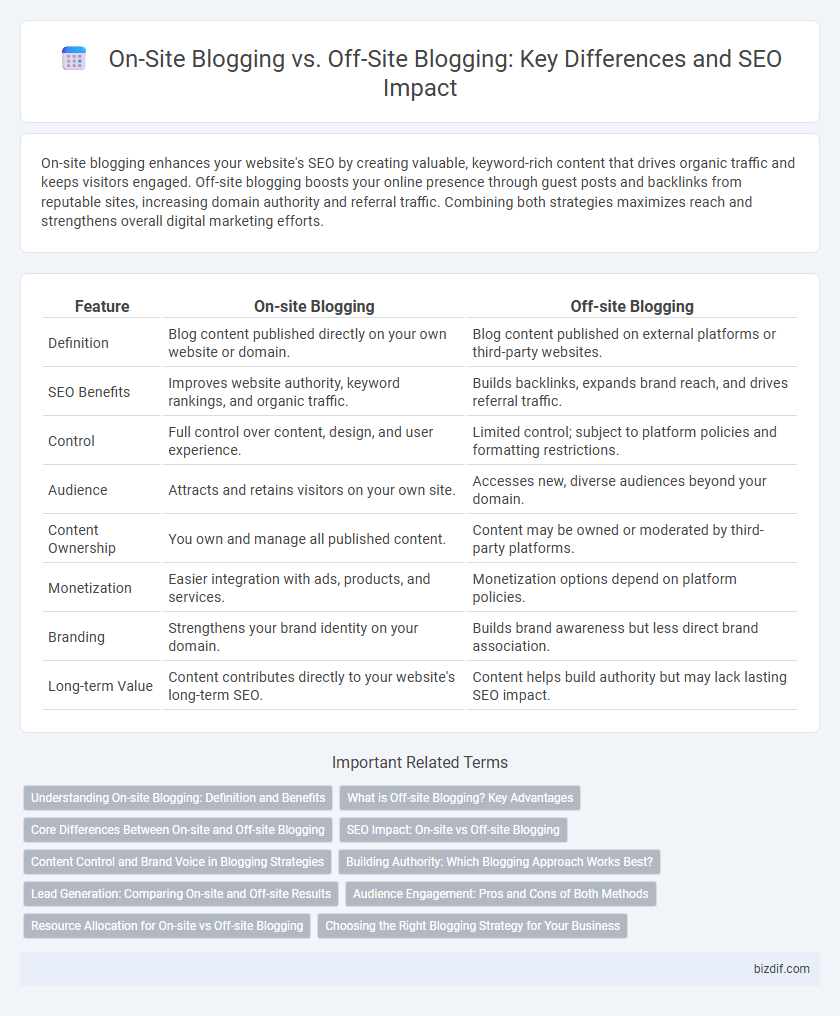On-site blogging enhances your website's SEO by creating valuable, keyword-rich content that drives organic traffic and keeps visitors engaged. Off-site blogging boosts your online presence through guest posts and backlinks from reputable sites, increasing domain authority and referral traffic. Combining both strategies maximizes reach and strengthens overall digital marketing efforts.
Table of Comparison
| Feature | On-site Blogging | Off-site Blogging |
|---|---|---|
| Definition | Blog content published directly on your own website or domain. | Blog content published on external platforms or third-party websites. |
| SEO Benefits | Improves website authority, keyword rankings, and organic traffic. | Builds backlinks, expands brand reach, and drives referral traffic. |
| Control | Full control over content, design, and user experience. | Limited control; subject to platform policies and formatting restrictions. |
| Audience | Attracts and retains visitors on your own site. | Accesses new, diverse audiences beyond your domain. |
| Content Ownership | You own and manage all published content. | Content may be owned or moderated by third-party platforms. |
| Monetization | Easier integration with ads, products, and services. | Monetization options depend on platform policies. |
| Branding | Strengthens your brand identity on your domain. | Builds brand awareness but less direct brand association. |
| Long-term Value | Content contributes directly to your website's long-term SEO. | Content helps build authority but may lack lasting SEO impact. |
Understanding On-site Blogging: Definition and Benefits
On-site blogging involves creating and publishing content directly on your own website, enhancing site authority and improving organic search rankings by offering relevant, original content that attracts targeted traffic. This approach strengthens brand identity, supports SEO strategies through keyword optimization, and increases user engagement by providing valuable information tailored to the audience. Businesses leveraging on-site blogging benefit from greater control over content management, improved site dwell time, and the ability to convert visitors into leads or customers effectively.
What is Off-site Blogging? Key Advantages
Off-site blogging involves creating and publishing content on external websites rather than a company's own blog, enhancing brand visibility beyond the primary domain. Key advantages include increased backlink opportunities that improve search engine rankings and access to diverse audiences, expanding potential customer reach. This strategy also builds authority and trust within niche communities by leveraging established platforms and influencers.
Core Differences Between On-site and Off-site Blogging
On-site blogging involves creating and publishing content directly on your own website, enhancing SEO by driving organic traffic and improving domain authority. Off-site blogging refers to guest posting or contributing content to external platforms, which primarily builds backlinks and broadens audience reach. The core differences lie in control, SEO impact, and audience engagement channels, with on-site blogging focusing on long-term site growth and off-site blogging emphasizing external visibility and link-building strategies.
SEO Impact: On-site vs Off-site Blogging
On-site blogging enhances SEO by regularly updating website content, increasing keyword relevance, and improving internal linking, which boosts search engine rankings. Off-site blogging generates backlinks from authoritative external sites, driving referral traffic and increasing domain authority. Combining both strategies maximizes SEO impact by improving on-page optimization and establishing credible off-site signals.
Content Control and Brand Voice in Blogging Strategies
On-site blogging offers complete content control and ensures consistent brand voice by hosting posts directly on the company's domain, enhancing SEO and user engagement metrics. Off-site blogging, such as guest posts on external platforms, provides broader reach but limits control over content presentation and brand messaging. Choosing the right balance between on-site and off-site blogging maximizes brand authority while optimizing content distribution strategies.
Building Authority: Which Blogging Approach Works Best?
On-site blogging strengthens domain authority by driving organic traffic directly to your website, improving SEO through consistent, keyword-rich content that engages your target audience. Off-site blogging builds authority by leveraging external platforms and guest posts to create high-quality backlinks, expanding reach and credibility across diverse networks. Balancing both strategies maximizes authority growth, with on-site efforts boosting internal SEO value and off-site contributions enhancing brand visibility and trust.
Lead Generation: Comparing On-site and Off-site Results
On-site blogging directly enhances lead generation by driving organic traffic to your website, increasing user engagement, and improving search engine rankings through relevant content integration. Off-site blogging builds brand authority and expands audience reach by contributing guest posts on high-traffic, related platforms, which can generate referral leads and increase backlinks. Effective lead generation strategies combine both approaches to maximize visibility, trust, and conversion opportunities across multiple channels.
Audience Engagement: Pros and Cons of Both Methods
On-site blogging enhances audience engagement by providing direct interaction through comments, personalized content, and immediate feedback, fostering a loyal community. Off-site blogging expands reach and drives traffic from diverse platforms but may dilute engagement due to less control over user interaction and brand consistency. Balancing both methods leverages sustained visitor connection on-site and broader exposure off-site, optimizing overall audience engagement strategies.
Resource Allocation for On-site vs Off-site Blogging
On-site blogging requires allocating resources toward website maintenance, content creation, SEO optimization, and user engagement to drive organic traffic and enhance domain authority. Off-site blogging demands investment in external platforms, outreach efforts, guest posting, and backlink acquisition to expand reach and improve search engine rankings. Efficient resource allocation balances time, budget, and personnel between producing high-quality in-house content and strengthening external link-building strategies.
Choosing the Right Blogging Strategy for Your Business
Effective blogging strategies hinge on understanding the impact of on-site versus off-site blogging on SEO and brand authority. On-site blogging enhances website traffic and engagement by regularly updating content within your domain, improving search engine rankings through targeted keywords and internal linking. Off-site blogging, such as guest posts on authoritative platforms, builds backlinks and expands your audience reach, boosting domain authority and credibility in your industry.
On-site Blogging vs Off-site Blogging Infographic

 bizdif.com
bizdif.com